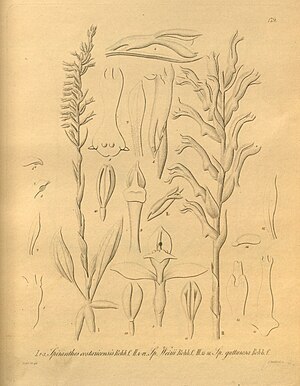Beloglottis
| Beloglottis | ||||||||||||
|---|---|---|---|---|---|---|---|---|---|---|---|---|

Beloglottis costaricensis |
||||||||||||
| Systematics | ||||||||||||
|
||||||||||||
| Scientific name | ||||||||||||
| Beloglottis | ||||||||||||
| Schltr. |
Beloglottis is a genus from the family of the orchid (Orchidaceae). It consists of about seven to ten types of herbaceous plants that are native to tropical America.
description
The species of the genus Beloglottis are small, herbaceous plants. They grow on rocks (lithophytic) or epiphytic , more rarely also terrestrial. The roots are hairy and somewhat fleshy, fusiform, thickened. Four to seven stalked leaves are in a rosette. They are oval to lanceolate in shape and taper to a point at the end.
The racemose inflorescence appears terminal, it is slender and upright. The inflorescence axis is glabrous in the lower area and hairy further up. At intervals it is covered with bracts , these surround it more or less tubular, they have a pointed end. The bracts are hairy glandular, lanceolate, also ending pointedly. The ovary is slender, slightly hairy, twisted, and not stalked. The numerous small flowers are loose or close together, they are resupinated . They are greenish-white in color and smell. The sepals are free or slightly fused together at the bottom, at least the lower half is hairy on the outside. They form a tube, only the tips are turned back. The lateral sepals are asymmetrical at the base. The lateral petals are attached to the dorsal sepal. The lip is abruptly narrowed (nailed) at the base, the narrow base is fused with the lateral sepals. Two nectar glands directed backwards follow in the transition to the wider front part of the lip (absent in Beloglottis ecallosa ). The lip of the lip is curved lengthways, the turned-up sides adhere to the column and form a tube with it. The column itself is rather short, asymmetrically protruding slightly over the ovary at the base (column foot). The column is partially fused with the dorsal sepal. The scar consists of two forward-facing surfaces that touch in the middle. The dividing tissue between the stigma and the stamen (rostellum) is divided into two parts. The stamen is oval, pointed at the front, slightly heart-shaped at the base. It is surrounded by a balloon-like inflated tissue of the column (clinandrium) and two staminodes . The pollinia are club-shaped, the narrow adhesive gland (Viscidium) sits between the rostellum lobes.
Occurrence
Beloglottis is common in tropical America. There it occurs from Florida in the north via Central America to the north of South America, the occurrence extends along the Andes to Peru and the extreme northwest of Argentina. The species occur from sea level to 2000 meters above sea level. They are found in rainforests and cloud forests, and occasionally in drier forests.
Systematics and botanical history
Beloglottis is classified within the tribe Cranichideae in the subtribe Spiranthinae . Related genera are Aulosepalum and Svenkoeltzia .
The name is made up of the components belos , "arrow" and glotta , "tongue" and refers to the shape of the lip.
While Gerardo Salazar writes about ten species, Kew Gardens only counts the following seven as Beloglottis :
- Beloglottis bicaudata (Ames) Garay : It occurs in Trinidad, Colombia, Ecuador, Peru, Bolivia and Venezuela.
- Beloglottis boliviensis Schltr. : It occurs in Bolivia and Argentina.
- Beloglottis costaricensis (Rchb.f.) Schltr. : It occurs in southern Florida and from Mexico to Brazil and Peru.
- Beloglottis ecallosa (Ames & C.Schweinf.) Hamer & Garay : It occurs in El Salvador and in Costa Rica.
- Beloglottis hameri Garay : It occurs from southern Mexico to Costa Rica.
- Beloglottis mexicana Garay & Hamer : It occurs from Mexico to Nicaragua.
- Beloglottis subpandurata (Ames & C. Pig ) Garay : It occurs in Guatemala, Honduras, Costa Rica and Panama.
No longer counted in this genus:
- Beloglottis laxispica Catling => Funkiella laxispica (Catling) Salazar & Soto Arenas
supporting documents
Most of the information in this article comes from:
- James D. Ackerman: Beloglottis . In: Flora of North America Editorial Committee (Ed.): Flora of North America North of Mexico . tape 26 . Oxford University Press, New York and Oxford, S. 522 ( eFloras.org [accessed January 3, 2008] 1993+).
- Leslie A. Garay: 225 (1). Orchidaceae (Cypripedioideae, Orchidoideae and Neottioideae) . In: Gunnar Harling, Benkt Sparre (ed.): Flora of Ecuador . tape 9 , 1978, ISSN 0347-8742 , p. 253 .
- Leslie A. Garay: A generic revision of the Spiranthinae . In: Botanical Museum Leaflets of Harvard University . tape 28 , no. 4 , 1982, pp. 302 .
- Alec M. Pridgeon, Phillip Cribb, Mark W. Chase, Finn Rasmussen (Eds.): Genera Orchidacearum. Orchidoideae (Part 2). Vanilloideae . tape 3/2 . Oxford University Press, New York and Oxford 2003, ISBN 0-19-850711-9 , pp. 174-176 .
Individual evidence
- ↑ Gerardo A. Salazar, Mark W. Chase, Miguel A. Soto Arenas, Martin Ingrouille: Phylogenetics of Cranichideae with emphasis on Spiranthinae (Orchidaceae, Orchidoideae): evidence from plastid and nuclear DNA sequences . In: American Journal of Botany . tape 90 , no. 5 , 2003, p. 777-795 .
- ^ G. Salazar: Beloglottis . In: Genera Orchidacearum. Orchidoideae (Part 2). Vanilloideae .
- ↑ a b c d e f g h i Rafaël Govaerts (ed.): Beloglottis. In: World Checklist of Selected Plant Families (WCSP) - The Board of Trustees of the Royal Botanic Gardens, Kew . Retrieved March 28, 2020.
Further information
Web links
- Photo of Beloglottis costaricensis from Orchidspecies
- Photo by Beloglottis costaricensis on Flickr